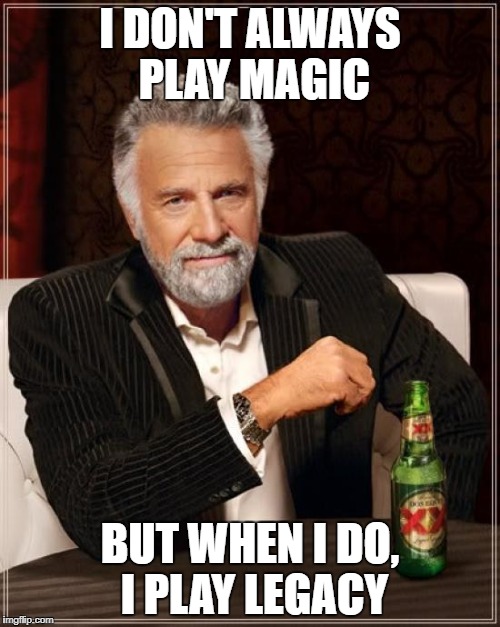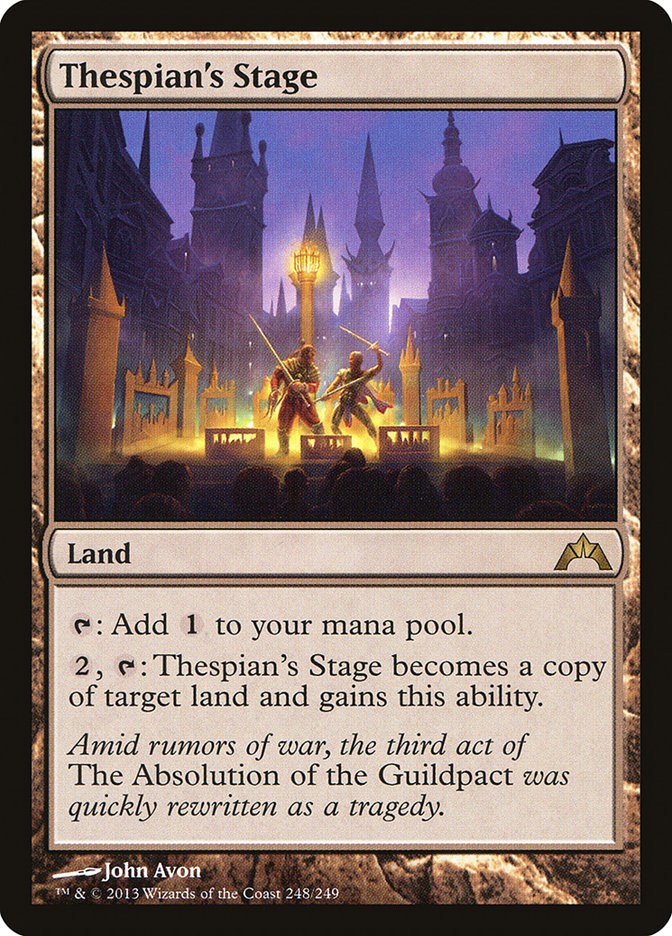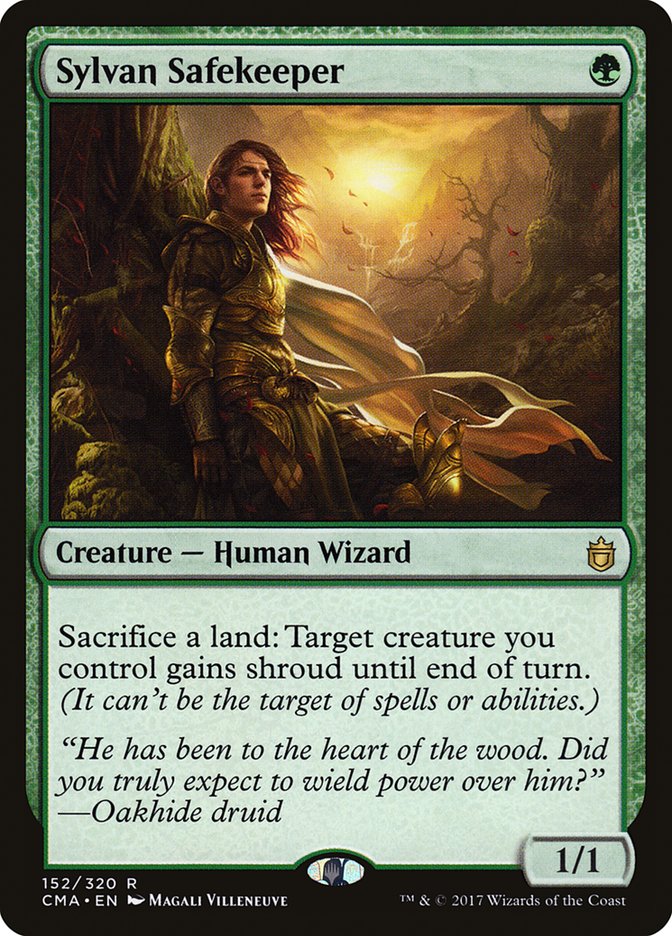Ah, Legacy. The Cadillac of Magic: The Gathering.
Where Wastelands and Brainstorms sit side by side with Dark Rituals and
Lion’s Eye Diamonds. The original removal spell, Swords to Plowshares,
hangs out opposite some of the most efficient creatures of all time, with
Sheriff Force of Will and Deputy Daze there to keep all the ruffians and
ne’er-do-wells in their place. It’s a wonderful and evergreen experience,
picking up those old dual lands for another workout. We will soon be back
to Worcester for an SCG Tour Legacy event, and I envy those of you who will
be in attendance. Too often, we let Legacy slip out of the forefront of our
minds, as there are many more Standard, Limited, and Modern events to
prepare for, but whenever we go back it reminds us that we are but humble
and fallible novices in the face of the intricate dance of two powerful,
well-tuned machines.
In order to properly get back into the right mindset for Legacy, it
behooves us to take a look at some of the perennial contenders and what has
happened in the interim since the last major Legacy event. New decks have
risen to the top, others have slipped, and (as always) I have a personal
decklist to offer up at the very end.
To begin, the once and future king of Legacy (at least until the rumored
Deathrite Shaman ban), Grixis Delver. Bob Huang, longtime Legacy specialist
and format enthusiast, has used hyperbolic language to describe his
personal Delver list, which he calls “the best deck in the format, bar
none.” Strong words from a usually-reserved player, but he has a point.
This deck just wins:
Creatures (15)
Lands (18)
Spells (27)

It’s an undeniably sturdy list. Bob’s been playing the same cards for
months now, and he claims to have reached format nirvana. With multiple
angles of attack including mana denial, the hated multiple-Delver draws,
Young Pyromancer to go wide, Gurmag Angler to present a one-mana 5/5,
Deathrite Shamans and Lightning Bolts for reach, and True-Name Nemesis to
obsolete traditional removal, Grixis Delver is an elite strategy that
offers tons of free win equity to those who pick it up. Even if you’re not
a format maven, it would be wise to consider just sucking it up and playing
the best deck. You don’t have to worry about grindy, drawn-out affairs with
a Jace deck, and you don’t have to sweat hate or interaction like the combo
or Lands decks. You just play undercosted threats, clock your opponent, and
counter their best attempts to keep up. Post-sideboard, you even have
powerful answers to narrow problems, like Surgical Extraction for
Reanimator, Dredge and Lands; Diabolic Edict for Lands, Turbo Depths, and
opposing True-Name Nemeses; Marsh Casualties for Elves and Death and Taxes;
and Ancient Grudge for Chalice of the Void. If you ever find yourself
waffling about what deck to play in the late hours before a Legacy event,
just do yourself a favor and play Grixis Delver.
But let’s say you don’t want to play the obvious best deck. You want to
play the most Magic possible. You want to play lots and lots of cantrips
and win with your good buddy Jace, the Mind Sculptor. Miracles is still
around in a new form, and if you want a mental workout, you can have a
blast keeping track of the order of the top of your library with cards like
Portent, Brainstorm, Ponder, Predict, and the like. Anuraag Das is obsessed
with Miracles, and his list is the go-to for anyone who likes flipping a
Terminus onto a cluttered battlefield.
Creatures (3)
Planeswalkers (3)
Lands (20)
Spells (34)
- 4 Brainstorm
- 1 Counterspell
- 4 Force of Will
- 4 Swords to Plowshares
- 3 Portent
- 3 Predict
- 3 Counterbalance
- 4 Ponder
- 1 Entreat the Angels
- 4 Terminus
- 1 Council's Judgment
- 2 Search for Azcanta
Sideboard

Another true work of art, this Miracles list provides clean card advantage,
plenty of interaction, a Counterbalance soft-lock that can put opponents in
fits, and a strong Delver matchup. With flexible answers and a less
mana-intensive card selection engine, Topless Miracles is almost as
powerful as its now-banned progenitor. The only problem, as always, is
finishing your matches in time. Make no mistake, it can be done, but you
simply must have crisp mechanics and be willing to prod slow opponents. If
that isn’t your cup of tea, then Miracles won’t be your best option.
That being said, if you want a deck with similar grindy elements but a
strong matchup against both Miracles and Delver, the next fair Brainstorm
deck is for you. It’s by far the most flexible deck in the format, with
options like a Punishing Fire package, heavier discard elements, weird
Planeswalkers–Dack Fayden or Ob Nixilis Reignited–and any removal or
disruption spell you can think of in four colors. I do not
personally recommend this list, but if you are looking for the closest
relative to Nic Fit that has a great shot to win a major tournament, look
no further.
“Clashed” on MTGO, whoever you are, I salute you.
Creatures (11)
Planeswalkers (5)
Lands (21)
Spells (23)

With respect to players like Grixis Midrange, Sultai Leovold, Temur Delver,
Sultai Delver, Esper Stoneblade, and a whole host of others, this concludes
the overview of the biggest fair Brainstorm decks. At risk of repeating
myself, the clear choice for an undecided player is stock Grixis Delver,
which is likely to be the most popular deck and still overperform at the
upcoming Open.
If you insist on playing an unfair Brainstorm deck, though, your best
options are Storm and Sneak and Show. These twin powerhouses of
non-interactive Magic have been cornerstones of Legacy for years now, and
remain among the best choices for players who like to win big. Neither of
them, however, is the absolute top choice for unfair Magic in contemporary
Legacy. No, the two best decks for cheesing out the opponent now are none
other than B/R Reanimator and Turbo Depths (again, assuming that you are
relatively inexperienced with Storm, as expertise is more mandatory with
that deck now than ever).
There are a number of potential tweaks for Turbo Depths, but the name of
the game is simple. Play a few discard spells (or don’t, up to you), make
Marit Lage come out of the icy prison with Thespian’s Stage or Vampire
Hexmage, protect it with Sylvan Safekeeper if necessary, and win at your
leisure. Sylvan Safekeeper is an incredible piece of tech for the deck,
preventing Swords to Plowshares from ending the 20/20 and soaking
up an otherwise-deadly Diabolic Edict that many opponents have floating in
their sideboards. As a starting point, “daft” has a list that seems crisp
and well-rounded. This is the feared Lands deck on easy mode, where you
cede the grindy potential of Life from the Loam in exchange for faster free
wins against combo decks. Often, a discard spell or two can lead into a
third-turn Marit Lage, and that is more than enough to get the win.
Creatures (11)
Lands (24)
Spells (25)
Sideboard

Let’s say you’d rather lose to Surgical Extraction than Terminus, though.
There’s one deck that is the Magic equivalent of going all-in blind every
hand, and if you can handle the risk, you can enjoy the reward. Putting his
royal Griselness on the battlefield on the first turn is one of the best
feelings in Magic, and that is what this deck aims to do. If Miracles is
the deck most likely to end up with unintentional draws every round, R/B
Reanimator is its polar opposite. “Hit ’em fast, hit ’em hard, and if they
whoop you, so be it,” might be the credo of Team Griselbrand. The list is
fairly stock at this point, but after looking at a few options, I prefer
this one by MTGO user “ewlandon”:
Creatures (10)
Lands (14)
Spells (36)

There are only a few things that a person can really mess with in this
list. One could play more Collective Brutality, different artifact hate,
and potentially change the makeup of the different reanimation targets, but
it’s simple and effective. If you win a tournament with this deck, though,
I believe there is a rider on Griselbrand’s contract that obliges you to go
to your nearest casino and throw all your winnings on black (or red, your
choice; there’s just something poetic about the roulette wheel being
painted in Rakdos colors).
At this point, we have exhausted most of the best archetypes in the format.
It says something about Legacy that the great divide is between the fair
Brainstorm decks and the unfair glass cannons, but a handful of
non-Brainstorm, somewhat interactive decks do exist and do win tournaments.
They are Death and Taxes, Lands, Elves, Colorless Eldrazi, and (dare I say
it) Burn. Unless you are an archetype expert with any of these, I must
caution that I do not recommend playing them.
Death and Taxes requires pilots to master timing tricks, figuring out when
to be aggressive and when to follow a mana denial plan, when to go for
which equipment with Stoneforge Mystic, and how to play around hate. Thomas
Enevoldsen can win with it, but that doesn’t necessarily mean you can pick
it up and expect to win at the same clip. Lands has been at times the
absolute best deck in Legacy, and still can fight with the best of them,
but unless you have hundreds of hours of reps with the deck, you will win a
lot more of your matches with something like Turbo Depths instead.
Elves is in a similar spot, where the matchups against the fair Brainstorm
decks are all close, and the matchups against the unfair decks are all
pretty bad. To that end, I do not recommend playing any Elves other than
Deathrite Shaman in your Legacy deck. Colorless Eldrazi suffers from an
increase in Baleful Strix and artifact removal among the fair decks, as
well as a relatively poor matchup against Turbo Depths and R/B Reanimator.
It’s eminently playable, but not as well-positioned as it was when it was
first created. And Burn? When Patrick Sullivan himself is bemoaning Flame
Rift’s spot in Legacy, it might be time to lay down the Lava Spikes.
I did promise my own preferred list for upcoming Legacy tournaments. It all
stems from my absolute adoration for Snapcaster Mage and my disdain for
Young Pyromancer. See, Young Pyromancer, while a strong card, is often not
particularly important in a wide range of matchups. Against Elves and Death
and Taxes, the important task is to break up an opponent’s battlefield and
sneak in damage with Delver or Deathrite Shaman. Against combo decks, the
important task is to pick apart their hand or counter their attempts to set
up while sneaking in damage with Delver and Deathrite Shaman (or Gurmag
Angler). Against Miracles, the important task is to stick and move, to
dance around their Terminuses and try to find a spot to protect a True-Name
Nemesis or to jam a bunch of creatures after the first Terminus. And
against the mirror match, the best thing you can do is leverage a mana
advantage for victory, playing heavy removal to keep your opponent from
being able to develop their battlefield to beat yours. Young Pyromancer
doesn’t do enough against the other synergy-based decks (Elves, D&T,
combo decks), as it requires you to spend two mana at sorcery speed and then cast a bunch of instants and sorceries to actually be
worth its salt. Far preferable is the flexible Snapcaster Mage, which can
serve as extra removal spells or extra discard spells depending on what’s
needed, and which allows you to position yourself as the “control” in the
semi-mirror against traditional Grixis Delver.
I’ve played Four-Color Delver before, and it may be time to play it again.
Here’s the list I’d take to any tournament with confidence that I’d be able
to put up a stiff fight against most of the popular decks in the format:
Creatures (15)
Lands (19)
Spells (26)

Volcanic Island sucks. There are no two ways about it. It does nothing for
your Deathrite Shaman, which is the biggest problem, and so Badlands
replaces one to give you more ways to cast the best turn-1 play in your
deck. The heavy discard element comes from the fact that you want reliable
disruption against the unfair decks and can’t rely on drawing the combo of
Gitaxian Probe and Cabal Therapy to truly stunt on the opponent. A good,
honest Thoughtseize is just fine. Potential changes include adding a third
Abrupt Decay to the list somewhere, putting an Ancient Grudge in the
sideboard, or playing a third Diabolic Edict to hedge harder against Lands
and Turbo Depths. Potential cuttable cards include the Dismember, one
Liliana, the Last Hope, a Marsh Casualties, and the Pithing Needle.
Standard comes and Standard goes. Modern, as we saw a few weeks ago, can
change in the blink of an eye. But Legacy stays. Legacy is the most
accessible link to Magic’s rich history. If you aren’t dipping your toes in
the Legacy waters, you are indeed missing out. If the Most Interesting Man
in the World played Magic…well, you get the picture.





